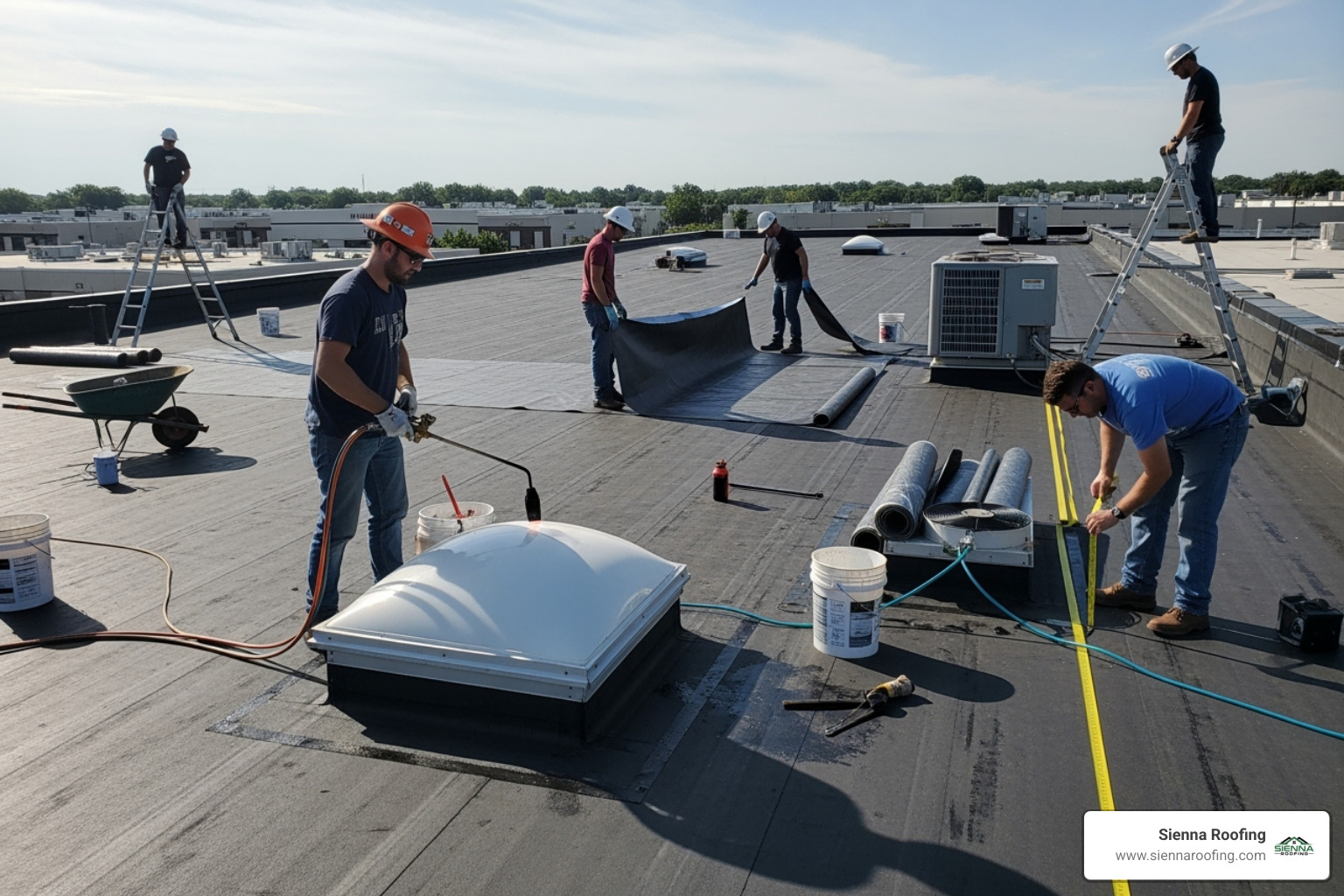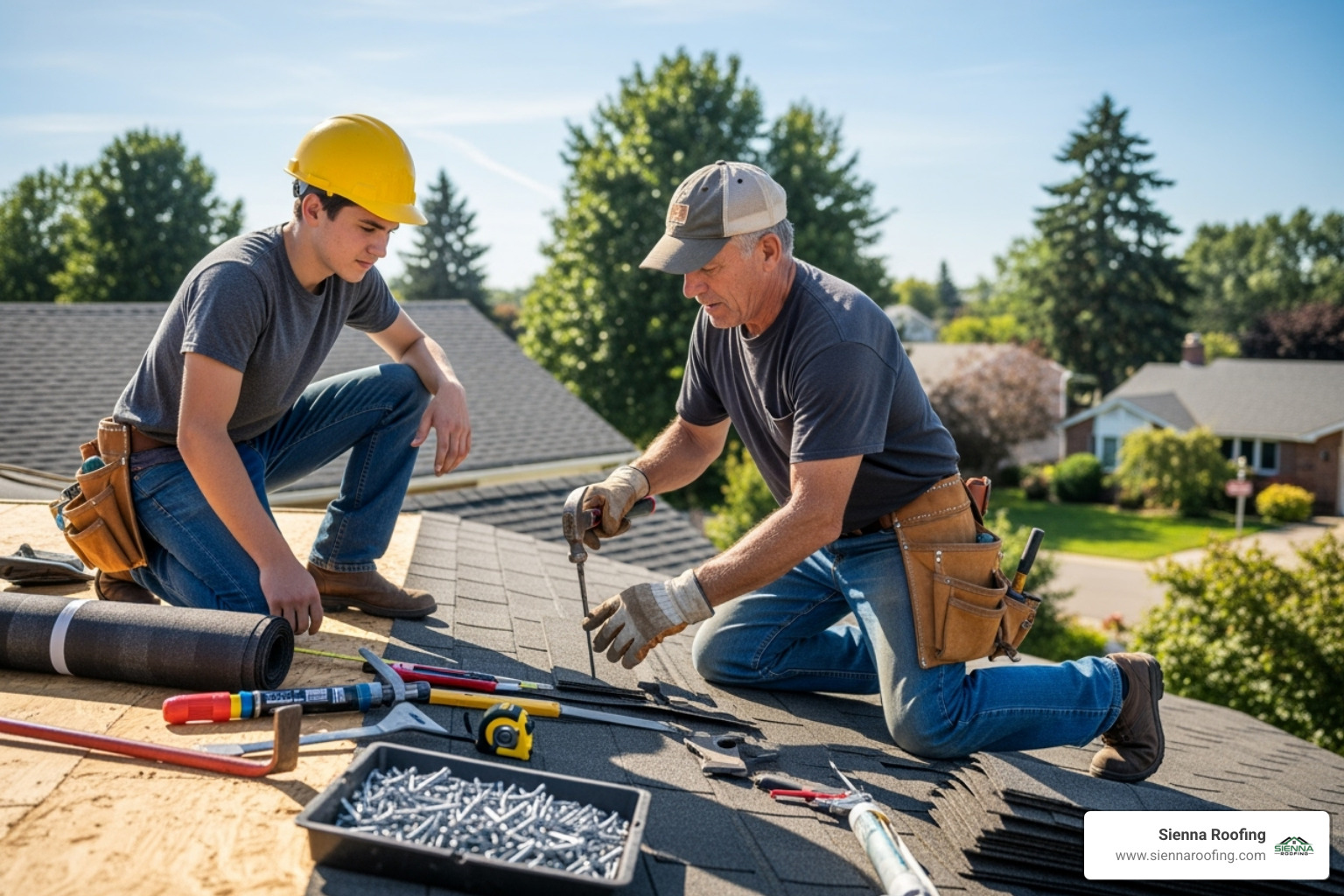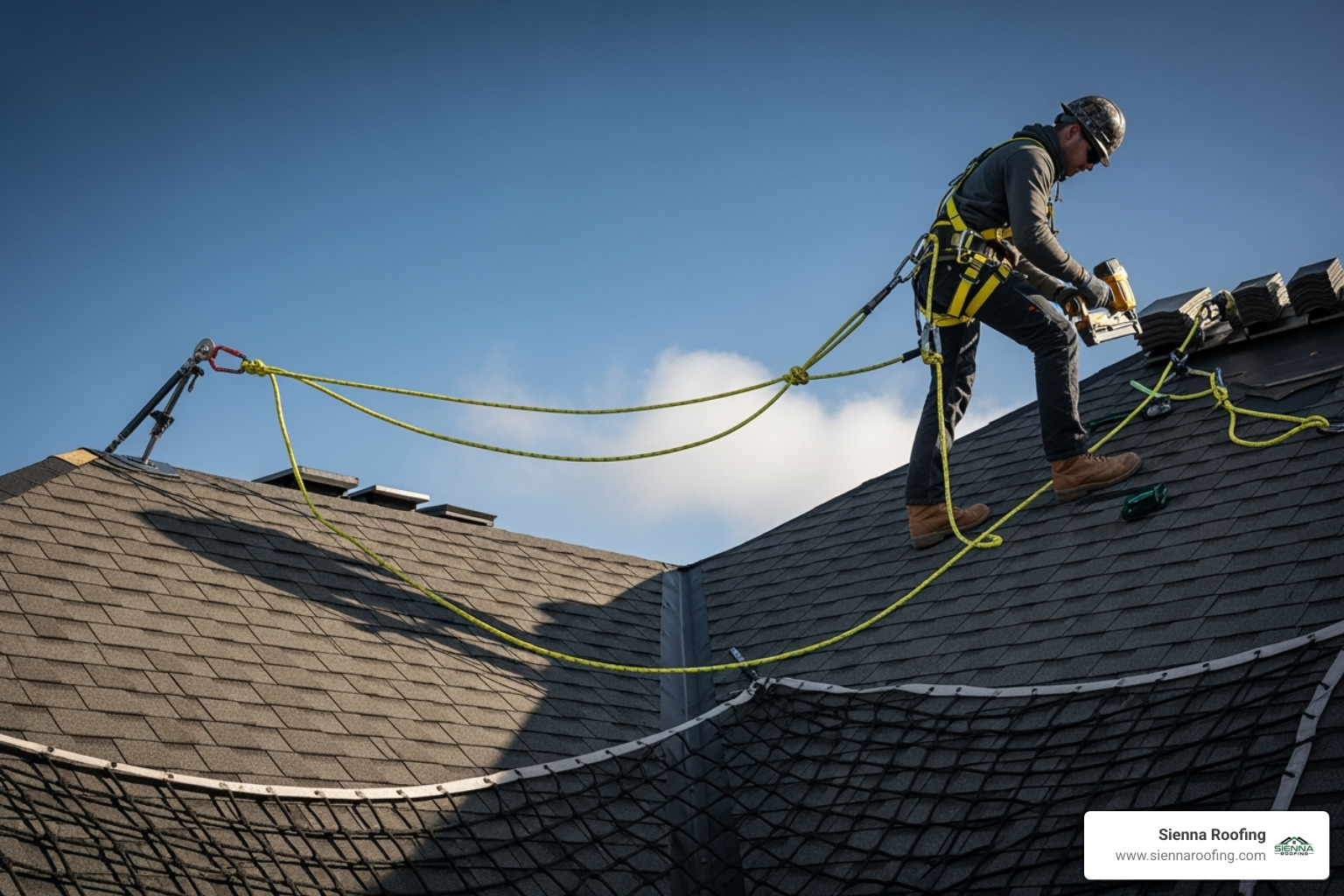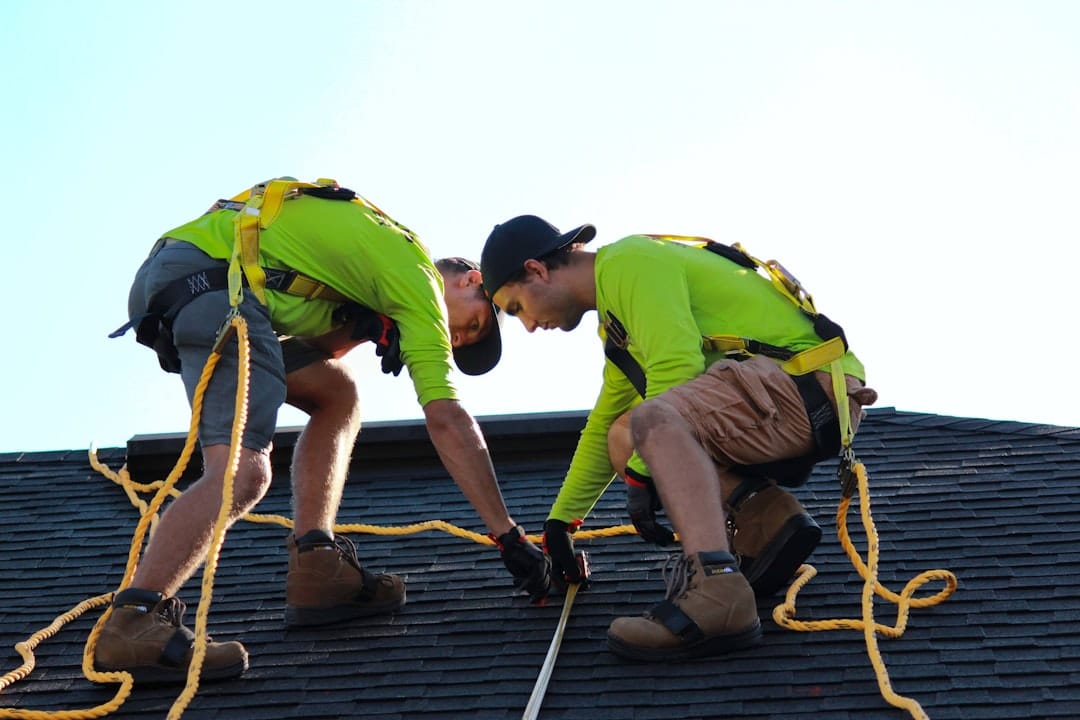Understanding the Roofer Profession
A roofer is a specialized tradesperson who installs, repairs, and replaces the roofs of buildings, a critical job that keeps homes and businesses safe from the weather. These professionals, also known as roof mechanics or roofing contractors, work with various materials to create durable, weatherproof barriers. At Sienna Roofing, we are proud to offer expert roofing and solar solutions to our community, backed by extensive industry experience.
This guide will explore the essential aspects of the roofing profession, from daily tasks to safety measures.
I’m Andre Castro, CEO and founder of Sienna Roofing & Solar, LLC. With a background in Construction Management from Texas A&M University and years of experience with reputable roofer companies, I established Sienna Roofing to deliver quality and reliability.

Roofer word roundup:
What is a Roofer? Defining the Role and Responsibilities
When you think about what keeps your home dry during a thunderstorm, you’re thinking about the work of a roofer. These skilled craftspeople ensure that the roof over your head does its job day in and day out. A roofer is a tradesperson who specializes in installing, repairing, and replacing roofing systems on both residential and commercial buildings. Their mission is to create a durable, weatherproof barrier that stands up to the elements.

The work of a roofer involves expertise in waterproofing and damp-proofing systems to prevent water damage. They must also assess existing roof systems to determine the best solutions. At Sienna Roofing, we offer comprehensive Residential Roofing services that go beyond simple repairs, bringing attention to detail and quality to every project, from homes in Sugar Land to large multifamily developments.
Types of Roofing Materials
A skilled roofer must be proficient with a wide variety of materials, each with its own benefits.
- Asphalt shingles are the most popular choice, offering a great combination of affordability and reliability. For more details, see The Ultimate Guide To Shingle Roofs No Shingle Left Unturned.
- Metal roofing is gaining popularity for its durability and energy efficiency.
- Clay and concrete tiles provide a distinctive look with excellent fire resistance and a long lifespan.
- Slate is a premium, natural stone option that can last for generations.
- Single-ply membranes like TPO and EPDM are common for commercial flat and low-slope roofs.
Common Roofer Tasks
The daily routine of a roofer requires a diverse skill set combining physical capability with technical expertise.
- Inspecting roofs to identify issues and determine the scope of work.
- Estimating materials and providing accurate, honest pricing.
- Removing old roofing carefully to avoid damaging the underlying structure.
- Installing new materials with precision and attention to manufacturer specifications.
- Waterproofing and sealing critical areas to prevent leaks.
- Flashing installation around chimneys and vents, which are common sources of leaks.
- Ensuring proper ventilation in attic spaces is also a key part of modern roofing. To see what happens when systems fail, read about What Is The Most Common Roof Repair.
The Path to Becoming a Professional Roofer
Becoming a professional roofer is a dedicated journey that blends hands-on experience with specialized knowledge. It requires dedication, an eye for detail, and a commitment to safety while working at heights.

Most aspiring roofers learn their craft through extensive on-the-job training, often as apprentices. This practical experience is usually combined with classroom learning through vocational schools or technical programs. Many also seek manufacturer certifications to prove their expertise with specific products, which can lead to better warranties for clients. In Canada, the roofer trade is recognized with a ‘Red Seal,’ a national standard of excellence. You can learn more about such programs at the Red Seal Program website. A skilled roofer must be physically fit, a good problem-solver, and eager to learn.
Essential Skills for a Roofer
The job of a roofer calls for a unique mix of physical and mental abilities.
- Excellent balance and no fear of heights are crucial for safety when working on sloped surfaces high off the ground.
- Physical strength and stamina are needed for lifting heavy materials, climbing ladders, and working long hours in various weather conditions.
- Attention to detail is paramount, as even a small mistake can lead to a costly leak.
- Teamwork is vital for communication and coordination on job sites.
- Basic math skills are used daily for measurements, material calculations, and cost estimates.
Training and Certification
The path to becoming a certified roofer is typically structured.
- A high school diploma or equivalent is usually the first step to enter an apprenticeship program.
- Apprenticeship programs are the most common route, combining thousands of hours of paid on-the-job training with hundreds of hours of in-school technical instruction. Apprentices learn about safety, tools, different roof systems, and maintenance.
- Manufacturer-specific training ensures roofers know how to install a product correctly, often allowing them to offer extended warranties.
- State licensing and insurance requirements vary by location in the U.S. but typically involve proving experience, passing exams, and carrying proper insurance. At Sienna Roofing, all our professionals are fully insured and credentialed for your peace of mind.
The Demands and Dangers of the Job
Being a roofer is a physically demanding job with inherent risks. A roofer works in challenging conditions, including extreme weather and at significant heights, requiring physical toughness and a strong commitment to safety.

The work involves heavy lifting, constant climbing, bending, and kneeling. Unfortunately, roofing is consistently ranked among the most dangerous professions. According to the U.S. Bureau of Labor Statistics, the fatal injury rate for a roofer is significantly higher than the average for all jobs, with falls being the primary cause. In 2021, the fatal injury rate was 59.0 per 100,000 workers, compared to the all-worker average of 3.6. These statistics underscore why safety is the most critical aspect of the roofing industry.
Primary Safety Hazards
A roofer faces numerous daily risks. The main hazards include:
- Falls from Roofs: This is the leading cause of death and serious injury in the profession.
- Slips and Trips: Wet, icy, or cluttered roof surfaces increase the risk of falling.
- Ladder Falls: Improper ladder use is a common source of injury.
- Electrical Hazards: Contact with power lines or faulty equipment can be fatal.
- Material Handling Injuries: Lifting heavy materials can cause strains and sprains.
- Sun Exposure: Prolonged exposure increases the risk of heat-related illnesses and skin cancer.
Understanding these risks is the first step toward prevention. The CDC offers helpful resources, including mobile apps, for fall prevention.
Fall Protection Systems
Due to the high risk of falls, robust fall protection systems are required by law from agencies like OSHA. These systems are vital for keeping crews safe.
- Personal Fall Arrest System (PFAS): This system includes an anchor point, a full-body harness, and a lanyard. It’s designed to safely stop a fall.
- Fall Restraint System: This prevents workers from reaching a fall hazard in the first place.
- Guardrail Systems: These barriers are erected around roof edges to prevent falls.
- Safety Net Systems: Installed below the work area, these nets are designed to catch a falling worker.
- Warning Line Systems: A rope or chain marks a boundary near an unprotected edge.
- Safety Monitoring System: A trained observer monitors workers in specific situations where other systems aren’t feasible.
These measures are essential for performing quality work while protecting our team. For tips on proactive roof care, see our article on How To Never Worry About Emergency Roof Repair Again.
Hiring a Qualified Roofer: A Homeowner’s Guide
Choosing the right roofer is a critical decision for your home. The quality of your roof affects your property’s safety, value, and energy efficiency. To avoid scams and poor workmanship from “storm chasers,” properly vet your contractor.

At Sienna Roofing, we believe in transparency and community focus. When looking for a roofer, prioritize insurance, licensing, local experience, references, reviews, and a written contract. These steps are your best defense.
How to Vet a Potential Roofer
To hire a trustworthy and skilled roofer, take these practical steps:
- Ask for proof of insurance: A professional roofer must have general liability and workers’ compensation insurance. Never hire a contractor without it.
- Verify licenses and certifications: Check for required local licenses and manufacturer certifications, which often lead to better warranties.
- Check the BBB and online reviews: Look for complaints on the Better Business Bureau website and read reviews on sites like Google to spot any patterns.
- Ask for references and a portfolio: A reputable roofer will gladly share past projects and connect you with satisfied clients.
- Inquire about worker safety: Ensure the contractor follows strict safety protocols and uses proper fall protection. This commitment reflects their professionalism. For more tips, see these 7 Signs That A Roofing Company In Sugar Land Is Trustworthy.
What to Look for in a Roofing Contract
A detailed, written contract is essential to protect all parties. Never proceed without one. Ensure it includes:
- Detailed scope of work: A clear list of all tasks, from tear-off to cleanup.
- Total cost breakdown: An itemized list of costs for materials, labor, and fees. Get at least three written quotes.
- Payment schedule: Limit the down payment (typically 10%) and never pay in full until the job is complete and you are satisfied.
- Project timeline: A clear start date and an estimated completion date.
- Material specifications: The brand, type, and color of all materials to be used.
- Warranty information: Details on both manufacturer and workmanship warranties.
- Lien waiver: This protects you from claims if the contractor fails to pay suppliers or subcontractors.
Sienna Roofing proudly serves homeowners across Sugar Land, Missouri City, Katy, and the greater Houston area. If you’re searching for a reliable Roofer Near Me, we are ready to help.
The Future of Roofing: Trends and Job Outlook
The roofing industry is continually evolving. For anyone considering becoming a roofer or for homeowners curious about what’s next, understanding new trends and the job outlook is important.

The demand for skilled roofers is steady. The U.S. Bureau of Labor Statistics projects about 12,200 job openings for roofers each year between 2022 and 2032, mainly to replace retiring workers. This indicates a lasting need for expert roofing professionals.
Emerging Industry Trends
The future of roofing includes several exciting innovations:
- Solar Roofs and Shingles: A rapidly growing field where the roof not only protects but also powers the home. Homeowners can save significantly on electric bills and may qualify for a 30% federal tax credit. Solar systems also protect the roof structure and help keep attics cooler.
- Metal Roofing: This material is seeing a jump in popularity due to its durability, longevity, and energy efficiency.
- Green Roofing and Sustainable Materials: This includes vegetative roofs, rainwater collection systems, and recycled materials, reflecting a move toward environmental responsibility.
- Cool Roof Technology: These roofs reflect more sunlight and absorb less heat, reducing energy costs for air conditioning.
- Drone Inspections: Drones make roof inspections safer and faster, allowing for quick damage assessment without climbing.
- Durable Materials: With more extreme weather events, there is a greater demand for high-performance, hurricane-resistant roofing options.
These trends show that the roofing profession is a dynamic field with new opportunities for skilled roofers.
Frequently Asked Questions about the Roofer Profession
Is roofing one of the most dangerous jobs?
Yes, roofing consistently ranks among the most dangerous professions. Working at heights in challenging conditions presents inherent risks. Statistics from the U.S. Bureau of Labor Statistics show the fatal injury rate for roofers is over ten times the national average for all workers, primarily due to falls. This is why safety is the absolute top priority in the industry, with strict adherence to safety protocols and the use of fall protection systems.
What is the difference between a roofer and a general contractor?
A roofer is a specialist who focuses exclusively on installing, repairing, and maintaining roof systems. They are the experts on everything related to the protective barrier over a home or business. A general contractor, in contrast, manages an entire construction project. They coordinate various specialists, including roofers, plumbers, and electricians, to ensure the whole project is completed successfully.
How long does it take to become a fully qualified roofer?
Becoming a fully qualified roofer typically takes 2 to 3 years through a formal apprenticeship. This journey involves thousands of hours of paid, on-the-job training under the supervision of experienced professionals, combined with several hundred hours of classroom instruction. This comprehensive process covers safety, techniques, and materials, ensuring a roofer develops true expertise.
Conclusion
The roofer profession is a skilled trade vital for protecting our homes and businesses. It’s a demanding career that combines physical work with technical know-how, offering both challenges and high rewards. While the job involves significant risks, the industry places a paramount emphasis on safety through rigorous training and advanced fall protection.
For homeowners, understanding this role and knowing how to choose a qualified expert is crucial. Always prioritize licensed, insured, and reputable contractors who provide clear contracts and references for your peace of mind.
At Sienna Roofing, we are proud to be part of this essential industry. We are committed to providing quality workmanship, ensuring the safety of our team, and delivering exceptional, community-focused service. If you have any questions or need expert roofing services you can trust, we’re here to help.




